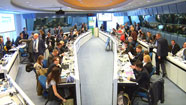On 5 April 2016 the JRC presented the interactive and collaborative online European Energy Efficiency Platform. This beta platform is conceived to fill the gap opened by scattered data and fragmented knowledge resulting from a rapidly growing energy efficiency market. It is expected to be both a one-stop shop for information retrieval and a meeting point for experts to exchange data and reduce redundant activities.
Follow up of the first workshop "Spatial data for modelling building stock energy needs"

The expert workshop "Spatial Data for Modeling Building Stock Energy Needs" took place on 24-26 November 2015 in Ispra, at the EC Joint Research Centre. It was jointly organised by the Institute for Environment and Sustainability (IES) - Digital Earth and Reference Data Unit and the Institute for Energy and Transport (IET) - Renewable and Energy Efficiency Unit of the JRC.
The main objective of this workshop was to share experience in data collection and methodologies to support energy efficiency policies and scope a possible pilot. The aim of a pilot project is to establish a harmonised approach supporting European Directives on Energy Efficiency (EED), Energy Performance of Buildings (EPBD) and the Covenant of Mayors (CoM) initiative using INSPIRE as a ‘location’ framework facilitating a harmonized exchange of data.
The invited experts to the workshop were chosen from different backgrounds, e.g. academic, business, research and government. A number of presentations have highlighted the challenges that are encountered when developing methods for a proper integration of energy systems in our society, in particular the built environment.
Up to 40% of final energy consumption is in the residential and tertiary building sector and has an important energy reduction potential and hence a contribution to reduce the GHG emissions in Europe. Expressed in kWh/m2 the average of the around 200 million dwellings in EU-28 is 185 kWh/m2 while the non-residential sector is estimated to consume 280 kWh/m2.
The recent technologies for gathering real data (metering) and elaborating data have to be employed and could contribute importantly to the goal of improving energy usage: “doing-more-with-less-energy”. The obtained information is important for making decision on refurbishment, investing in renovation and managing the energy flows
The problem of building definition was discussed. It became clear that the EPBD, INSPIRE and the construction Eurocodes apply different definitions which is leading to confusing results in the assessment. It is also noted that confusion starts from expressing energy in terms of performance, efficiency and consumption that are related but not the same. This aspect needs more attention when databases will exchange data for calculation purposes. As an example of different definitions can be the fact that the EPBD considers for energy performance assessment the heated spaces of a building whereas a building footprint (INSPIRE) may lead to other dimensions for floor area and hence will have different expressions for the energy consumption expressed in kWh/m2. Several cases were presented how databases contain building information.
Data availability is seen as a barrier to overcome. The main issue is privacy of data; who decides which data is available and who may have access to the data? Anonymisation is key and some have reported an approach to deal with it. It is clear that Member States (and local governments) are dealing in different ways with this issue.
Several participants mention that end-user involvement in reducing energy consumption comes from motivation by awareness. This requires a simple and clear communication system for which modern information technology (IT) is becoming available. More frequent information is needed than only the regular energy consumption bill. The importance of metering is recognized since it offers actual consumption data.
A general approach is difficult to give and the conclusion should be that different methods should be developed that serves different parties. It is therefore important to distinguish at least three actors: policy and decision makers, industry and energy providers and finally the end-users of energy in the building sector. In other words: end-users are interested in real consumption data and probably to decide for investment in renovation; local or national governments are interested in data for modelling and planning whereas industries and energy providers are interested in innovation of products and energy flow data for management of demand and supply.
A good method depends on available information in the data and the requirements for output (which can be a value, a series of data or graphical representation). This will impact the level of detail of the method and the underlying calculation model(s). A stepwise development of a method as is applied for CityGML could be followed for Energy, Buildings and Location. INSPIRE facilitates the data exchange between databases and application software tools, e.g. methods. A layered approach of databases could be an acceptable method.
In that context the issue of scaling has to be placed; the requirements of the EPBD, the EED and CoM are different and implies different although related, methods with specific levels of detail. One may put the question also: what uncertainty is expected for which method? What uncertainty is acceptable at the different level of details required?
It has been emphasized by several experts that academic support is essential for the development of methods. Innovative approaches will have to be incorporated in software tools as well as devices for communication and management.
A pilot study should focus on issues of: scaling (from building to building stock), data requirements and treatment (including anonymization and uncertainty), connecting databases by conversion and control routines.
The organisers concluded a very successful workshop and have invited all participants to join the proposed informal network on Energy and Location to take part in the further discussions and actions.
These conclusions and more detailed information about the discussions held in November can be found in the Workshop Proceedings.




To quote this article use the follonwing format: